
What is the best material for kitchen cupboards?
As the focal point of your kitchen, cupboards are an essential part of your design.
They give your kitchen character and store all your appliances, utensils and ingredients. As such a defining part of your space, your choice of cupboard materials should never be overlooked. There are a wealth of options built to fit your unique style, function, and budget.
Whether you’re building a new house or giving your kitchen a makeover, Seeff covers some of the cupboard material types which will give your kitchen an instant wow factor. CCMI Kitchen and Cupboard Specialists has rated each material (1 being the lowest score to 10 being the highest score for each category) to help you decide based on affordability, durability, and style. They also recommend that you speak to a professional kitchen company about the materials you would like to use whether you plan to do it yourself or have the experts do the work.
Share This Post
- Solid wood
- Plywood
- Hardboard
- Melamine
- Medium-density fibreboard (MDF)
- Vinyl wrap (Polyvinyl chloride foil)
- Polyurethane
- Metal
- Glass
- Plastic (PVC foam board)
Solid wood
If you're after a classic look that takes you back to a bygone era of stately homes and old-world charm, you'll love solid wood or hardwood. As its name suggests, it’s made completely from wood like cherry, teak, pine, and oak, to name a few options. Solid wood comes in a range of beautiful textures, colours, and grains. It can last years and is easy to keep clean.
- Price: 1/10
- Durability: 9/10
- Style: 8/10
Price: 1/10
Not only is solid wood the most expensive material option for kitchen cabinets, but natural wood also requires frequent maintenance – which adds to the expense of the material in the long run. Solid wood should be viewed as an investment into the value of your property when selected as a material for your kitchen cabinets and should be treated with care to protect its value.
Durability: 9/10
Wood is a natural (living) material and is prone to decay if not maintained correctly. However, proper care and maintenance can ensure that solid wood will last for many decades or even centuries. As with the price, not all woods are the same – please get professional advice to ensure you have a suitable type of wood.
Style: 8/10
Nothing can beat the warmth and tactile sensation of solid wood. This material often goes hand in hand with feelings of nostalgia and sentimentality, which makes it an excellent choice for heritage homes or homes that have an organic style.
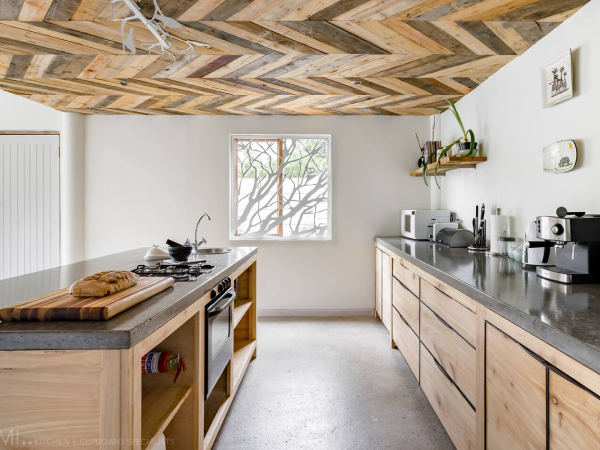
Plywood
If you’re after a budget-friendly look, plywood comes in different grades and pricing. It’s made by glueing, heating, and pressing layers of thin wood, on top of each other and at different angles. The result is an incredibly resilient material. Because solid wood is vulnerable to moisture and termite damage, plywood is often given a decorative laminate to make it more resistant. If you have a DIY spirit, you’ll enjoy how easy it is to install plywood cupboards in your kitchen.
- Price: 5/10
- Durability: 7/10
- Style: 7/10
Price: 5/10
Various grades exist on the market, and price points can vary quite dramatically. Some of the more expensive plywood options are worth the investment as the boards are of higher quality and are likely to be more durable in the long run.
Durability: 7/10
The durability of plywood depends on the manufacturing process and the intended purpose of the board. It is wise to ask about the available options before committing to any particular grade of plywood for your kitchen cabinets.
Style: 7/10
Plywood can be an enormously fun material for modern minimalistic kitchens. Scandinavian-inspired interiors often make use of this material. The variety of laminate finishes that are available make plywood a great option for youthful spaces that incorporate design elements such as colour blocking.
Hardboard
Also known as masonite, this is wood fibres compressed into a sheet in a high-temperature press. Because it is flexible and can bend into curved shapes, you’ll find several stunning cupboards in this material. Hardboard is often treated with chemicals to make it repel damage from moisture, insects, fire, and general decay.
- Price: 10/10
- Durability: 4/10
- Style: 4/10
Price: 10/10
Hardboard is an affordable material, but what it saves in initial outlay may result in unnecessary repair costs later on. Hardboard is an inexpensive material for the backing of cabinets, and it is often used for this purpose. It is less commonly used for cabinet fronts, but it is a cost-effective material which can be used if curved cabinetry is desired.
Durability: 4/10
If cared for properly, hardboard can be very durable but, as a rule, it would not be recommended for cabinets. With the right finish applied (such as a polyurethane sprayed finish) the durability of the hardboard may be improved. Warping and flaking of the board are the most common signs of wear and tear often due to exposure to moisture or heat. A hard knock to a hardboard cabinet front may result in partial collapse of the board due to impact, whereas solid substrates will be more resistant to damage incurred by knocks and bumps.
This material is often used as a backing for the interior of cabinets where a slim profile is preferred; however, due to the nature of the board it is not particularly well suited to holding the weight of wall-mounted cabinets.
Style: 4/10
Hardboard is an excellent substrate for painted finishes; if you're considering a kitchen with curves in the cabinetry and a unique colour, this material is a viable option in conjunction with other materials.
Melamine
Perhaps the easiest choice for your pocket, melamine has been a favourite in kitchens for decades. This is made when pressed wood, plywood, or similar material is topped by a layer of paper coloured with a heat-fused melamine resin. Melamine kitchen cupboards are a practical addition as they don’t need to be restained or sealed and are a joy to clean.
- Price: 9/10
- Durability: 8/10
- Style: 7/10
Price: 9/10
Melamine is quite affordable and is the material most often used in kitchen cabinetry. There are many options available on the market which vary in price quite drastically. Some melamine boards are superior in quality and carry a price tag to match.
Durability: 8/10
Durability comes down to the manufacturing process, with factors such as the substrate (generally chipboard) and quality of the lamination coming into play. Good quality melamine boards are very durable and will last for many years if installed correctly.
Style: 7/10
Technology has advanced hugely over the last few years elevating melamine boards from a "cheap-and-nasty" option to an "innovative-and-trendsetting" material. Local manufacturers have upped their game bringing reasonably priced options to the market – these have become competitors to the high-end internationally manufactured boards. With such a large variety of colours and textures available in melamine finishes, nearly any style can be achieved without breaking the bank.
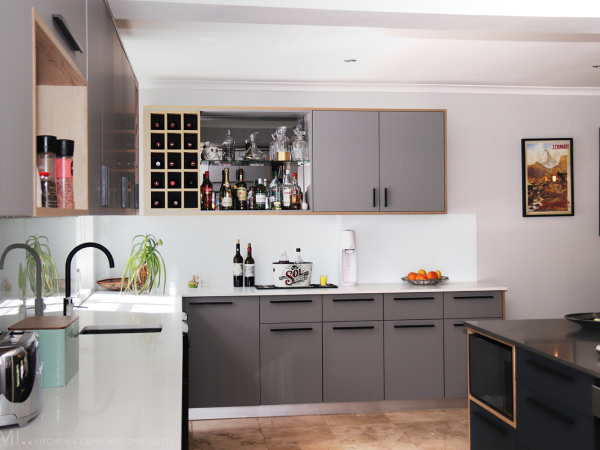
Medium-density fibreboard (MDF)
With natural fibre furniture all the rage, you can keep your green efforts going in the kitchen thanks to MDF. It’s made up of small wood particles and fibres (often recycled) that are mixed with wax and resins. If you’re particular, you’ll appreciate the even grain. With a smooth texture, it also takes paint well, making MDF cupboard doors a fabulous addition to your kitchen.
- Price: 8/10
- Durability: 6/10
- Style: 8/10
Price: 8/10
MDF is a reasonably priced substrate for mid-range to high-end finishes.
Durability: 6/10
MDF is very durable when finished with the right product. MDF's greatest weakness is exposure to moisture; however, with correctly applied high-quality finishes moisture damage is seldom seen. It is the preferred substrate for PVC-wrapped door profiles, as well as for spray-painted finishes.
Style: 8/10
MDF can be expertly crafted into a multitude of designs and styles. Computerised Numerical Control (CNC) technology may be used to create attractively textured surfaces using MDF as the foundation. This truly is a versatile material with seemingly endless possibilities.
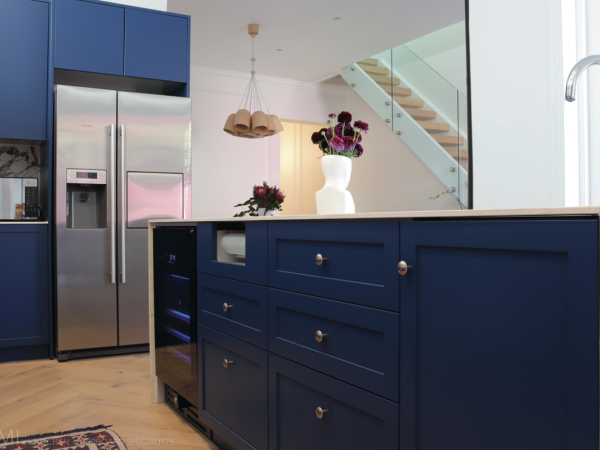
Vinyl wrap (Polyvinyl chloride foil)
Vinyl (PVC) wrapped doors and panels are a practical, versatile, and attractive option for your kitchen. The vinyl itself comes in a large variety of colours and textures, including solid colours and wood grains, and the finish can be matt, textured, or even gloss!
Cabinets with this finish have a similar easy-to-clean and moisture-resistant surface to melamine; however, foils may be applied to cabinets which have ornamental routing in the surface giving you a much more extensive range of style options than melamine. Top-quality vinyl wrapped doors emulate premium finishes so well that in some cases, at first sight, you may have trouble distinguishing between vinyl and polyurethane.
- Price: 5/10
- Durability: 6/10
- Style: 7/10
Price: 5/10
Due to the massive range of colours, textures and varying thicknesses of PVC foils, prices can vary quite a bit, but this is a relatively affordable option for achieving a high-end look and feel to your kitchen.
Durability: 6/10
Applied to a (usually MDF) substrate using a high-pressure vacuum to bond the foil to the board, vinyl wrap is a very durable option. PVC is resistant to most chemicals including greases, oils, and water damage. Foil-wrapped doors also take knocks really well; impact marks are less likely to be visible than on polyurethane finishes which may chip (if knocked with excessive force). Heat and moisture are vinyl’s greatest adversaries, so avoid having PVC-wrapped doors directly above an oven as the foil will become warped or brittle.
Style: 7/10
Vinyl finishes can be applied to such a large variety of decorative door profiles that it is certainly a level up from the purely flat profiles that can be achieved with melamine. The range of colours and textures available makes it more versatile than polyurethane which would require great skill if an artistic wood-grained or patterned finish is desired.
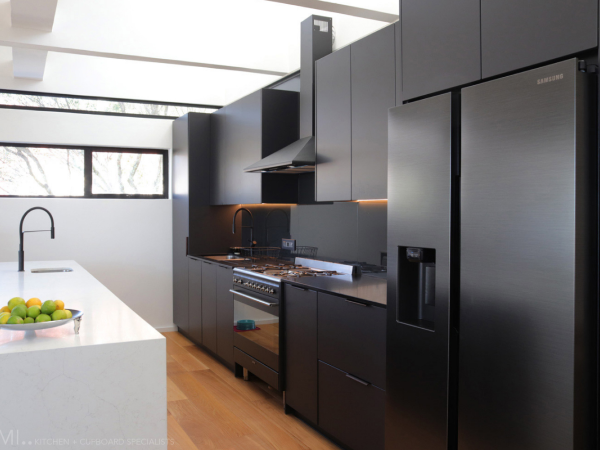
Polyurethane
Another favoured built-in cupboard material for your kitchen, polyurethane is a coating of paint-like product that is sprayed directly onto an MDF substrate. Your imagination is the limit with this option: it offers an unlimited palette of colours, patterns, and textures. Polyurethane is hardy, taking knocks and scratches with ease. Easy to clean, they’re also a delight in sunny kitchens as they won’t fade or crack from exposure.
- Price: 3/10
- Durability: 7/10
- Style: 9/10
Price: 3/10
High-quality polyurethane finishes do come at a cost, but if you are looking for a truly bespoke finish this option may be worth the investment.
Durability: 7/10
Polyurethane sprayed finishes are considered to be a premium finish as the quality of paints used is equivalent in durability to paint finishes used for automotive applications. Unfortunately, as with any painted surface, there is always a risk of visible scratches and chips if the surface is exposed to abrasives or knocks and scratches using excessive force.
Style: 9/10
A highly skilled spray painter may be able to achieve any number of artistic finishes using polyurethane coatings, and if expertly applied the style possibilities are seemingly endless. Just as with solid wood surfaces, the tactile appeal of polyurethane finishes is superior to other materials that may be used to achieve a similar look.
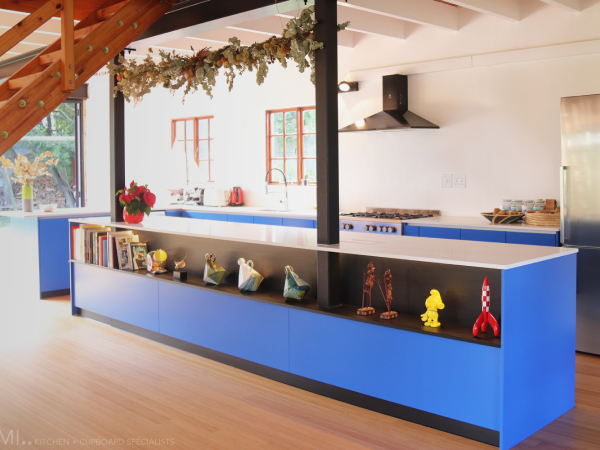
Metal
Metal kitchen cupboards have become popular for those leaning towards an industrial or modern look. In your kitchen metals will also resist stains, won’t warp in high heat and humidity, and remain the same as years go by. Stainless steel and aluminium are good options to achieve a sleek look. You can even mix your metals with glass or wood to soften the appearance.
- Price: 3/10
- Durability: 9/10
- Style: 9/10
Price: 3/10
Metals vary quite drastically in price depending on the base metal and the treatments that are applied to it. The best thing to do, should you wish to include metal elements in your kitchen design, is to speak to your kitchen designer about the available options to find out which metal would be best suited to your needs.
Durability: 9/10
The durability of metal goes without saying! The largest risk of damage to metal is of course rust, and the likelihood of rust setting in on treated metal is very slim.
Style: 9/10
Metal has the ability to bring an unexpected dimension to your kitchen design. Whether you desire a bold style statement or subtle details that occasionally catch the eye, introducing metal elements to your kitchen is a wonderful way to do either. More than any other material, the use of metal in kitchen design is far from being completely explored and a designer with vision may find new innovative ways to include this material creating a style that is uniquely you.
Glass
Have you ever rummaged around your kitchen to find a specific ingredient or utensil? Having glass-fronted cupboards can come to the rescue. They can help you keep your kitchen organised and even be a point of pride to display some of your items. Glass kitchen cupboards are also easy to clean — some liquid soap and water are enough to bring back the sparkle.
- Price: 5/10
- Durability: 9/10
- Style: 8/10
Price: 5/10
Glass is available in so many different options that prices can vary dramatically. The price will depend on the unique features of the glass, such as texture, colour, or thickness, but that does not mean that glass is an unaffordable material by any means.
Durability: 9/10
This notoriously fragile material certainly does have a place in the kitchen; however, care should be taken with selecting the right kind of glass to ensure that glass elements are safe and durable. Tempered glass is made to withstand heat and impact and can last for many years without showing any signs of wear.
Style: 8/10
Glass splashbacks are a popular feature in modern kitchens, whereas glass panels in cabinet doors are quite traditional, but no matter which way your personal style leans there is sure to be a niche for glass in your design. Mirrors are another way of introducing glass into your design, and they can be very effectively used in cabinet and kitchen designs giving your space an elevated look and feel.
Plastic (PVC foam board)
With a range of benefits, plastic truly is fantastic for your kitchen cupboards. The material resists corrosion, moisture, and insect damage. In this way, plastic cupboards are becoming more common in coastal areas where salty air can rot wood or corrode metal. Kitchen stains and splatters also don’t stand a chance with plastic. Your cupboards can simply be wiped down during messier activities.
- Price: 7/10
- Durability: 5/10
- Style: 5/10
Price: 7/10
Considering that plastic lasts a lifetime and the kind used in kitchens is 100% recyclable, PVC foam board is a cost-effective material regardless of the initial price. PVC boards are fairly well priced and if you consider the benefits of having a kitchen that is resistant to moisture and insect damage, this might be a great option for you.
Durability: 5/10
There are two kinds of PVC board available on the market, but only the dense foam board is recommended for use in cabinet construction, as hollow PVC boards are not strong enough to create weight-bearing structures. Plastic cabinets can last a lifetime, however, the surface is prone to being easily scratched and may show irreparable signs of wear and tear over time.
Style: 5/10
Plastic truly is fantastic when it comes to mimicking other materials. The variety of PVC foam boards available range from solid colours through pearlescent and metallic options all the way to natural-looking wood grains, and come in a variety of finishes from high-gloss to matte. Plastic is by no means a traditional material and may not be your first option. But, if you are an innovative thinker and would like to try something different to create something unusual then this might just be the material you didn’t know you were looking for.
Find your dream kitchen
Your kitchen is the heart of your home. Every detail from the cupboards to the counters should make your culinary experience all the better. Seeff’s property practitioners know home is your story, and we’d love to help you write a delicious one! Contact our team for property sales and letting assistance.
Based in Cape Town, CCMI Kitchen and Cupboard Specialists provide all-inclusive kitchen and cupboard design, manufacture, and installation services. They work and collaborate with leading suppliers, interior designers, property developers, and architects providing them with their bespoke joinery solutions. Get in touch to start your next project.







